The beauty industry is huge, and still growing. The US is one of the largest markets, and there’s always room for appealing and innovativeprod ...
You might consider targeting a niche market by specializing in a certain aspect of your industry.
We earn commissions if you shop through the links below. Read more
Written by: Carolyn Young
Carolyn Young is a business writer who focuses on entrepreneurial concepts and the business formation. She has over 25 years of experience in business roles, and has authored several entrepreneurship textbooks.
Edited by: David Lepeska
David has been writing and learning about business, finance and globalization for a quarter-century, starting with a small New York consulting firm in the 1990s.
Published on November 11, 2021

Investment range
$850 – $7,800
Revenue potential
$25,000 - $500,000 p.a.
Time to build
Less than 1 month
Profit potential
$12,500 - $150,000 p.a.
Industry trend
Growing
Commitment
Flexible
When opening your lip gloss business, keep these essential aspects in mind:
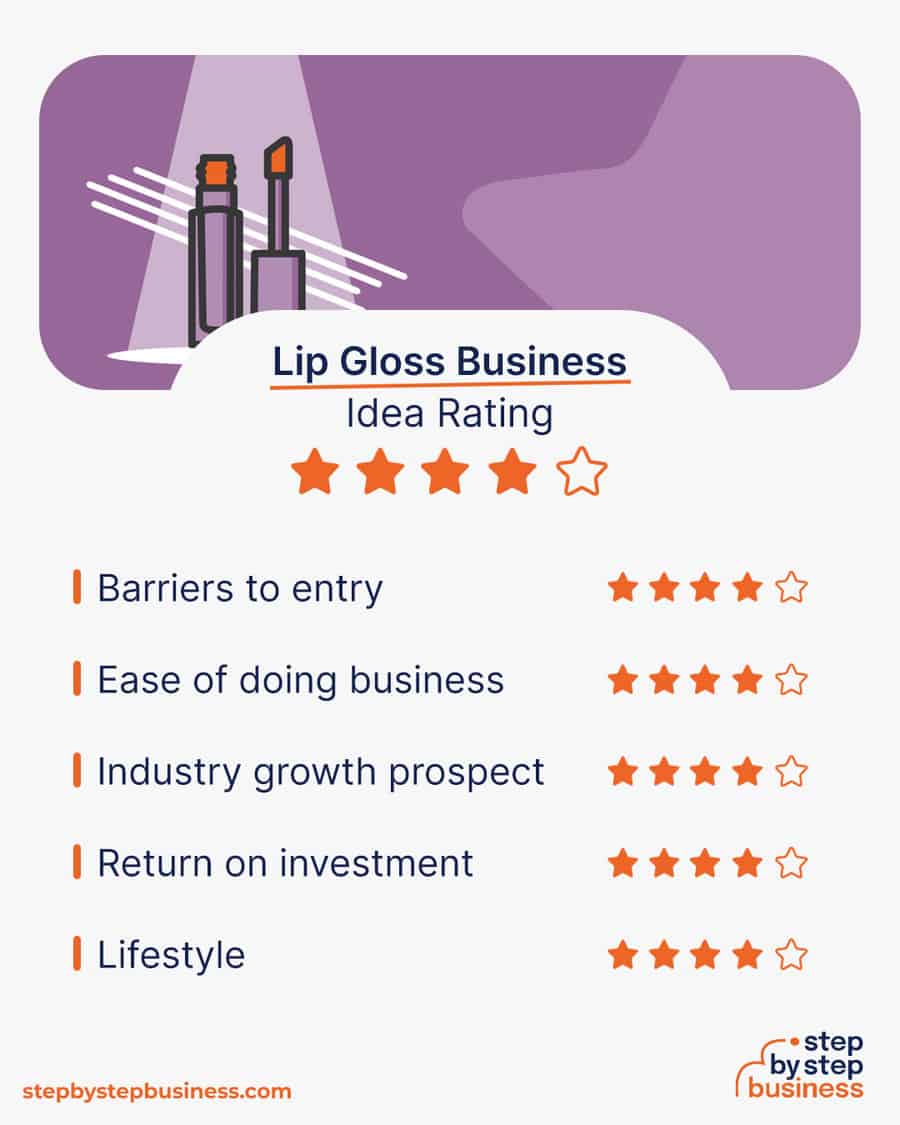
No business is perfect. A lip gloss business has pros and cons that you need to weigh to decide if it’s the right path for you.
At the end of 2020, Google searches for non-sticky lip gloss were up 90%, according to InStyle magazine.((https://www.instyle.com/beauty/makeup/lipstick-trends-2021))
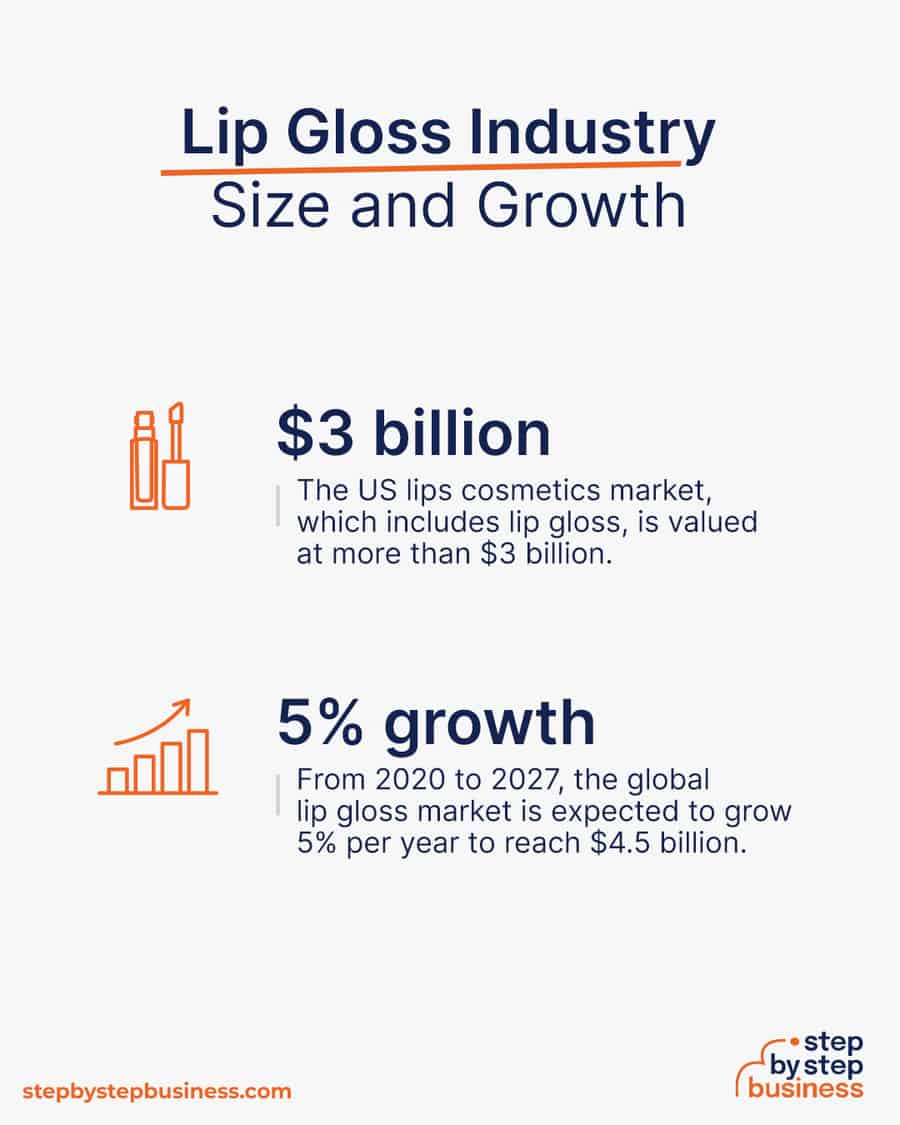
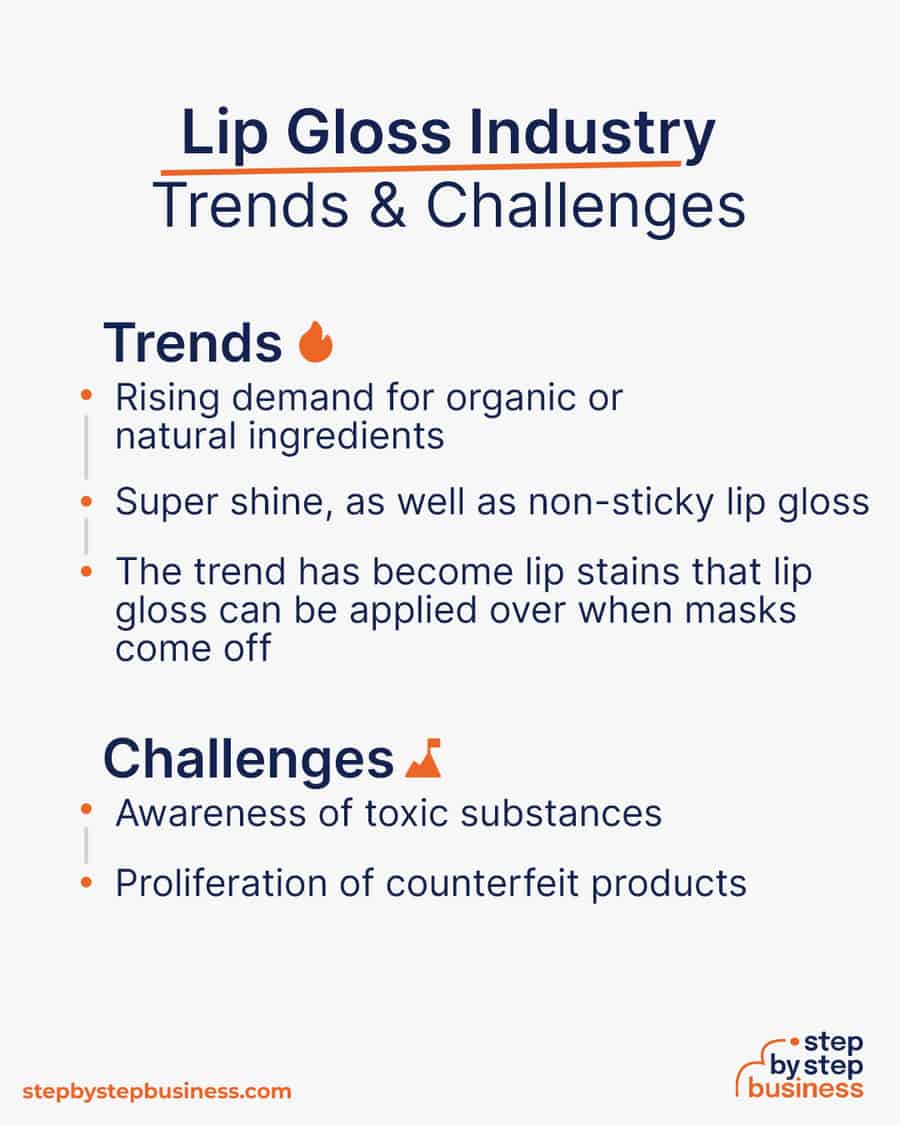
Trends in the lip gloss industry include:
Challenges in the lip gloss industry are:
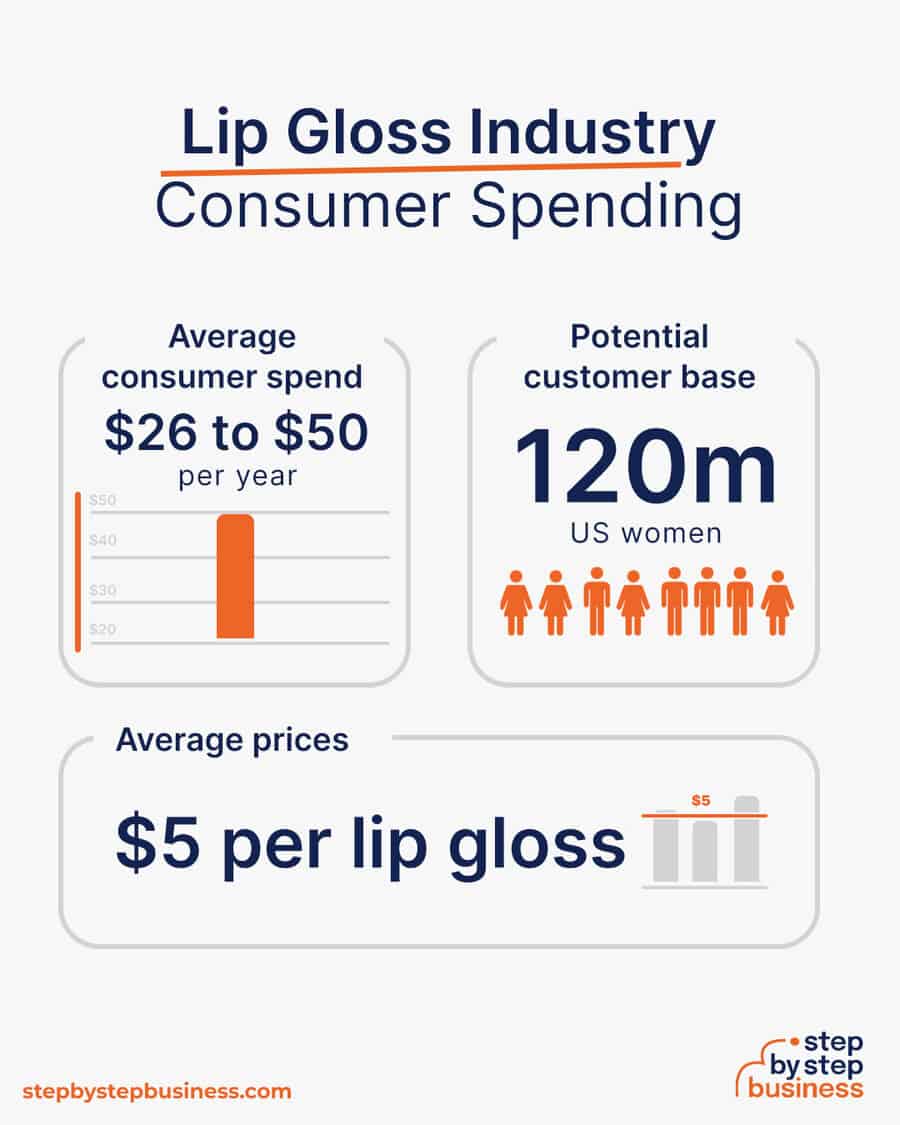
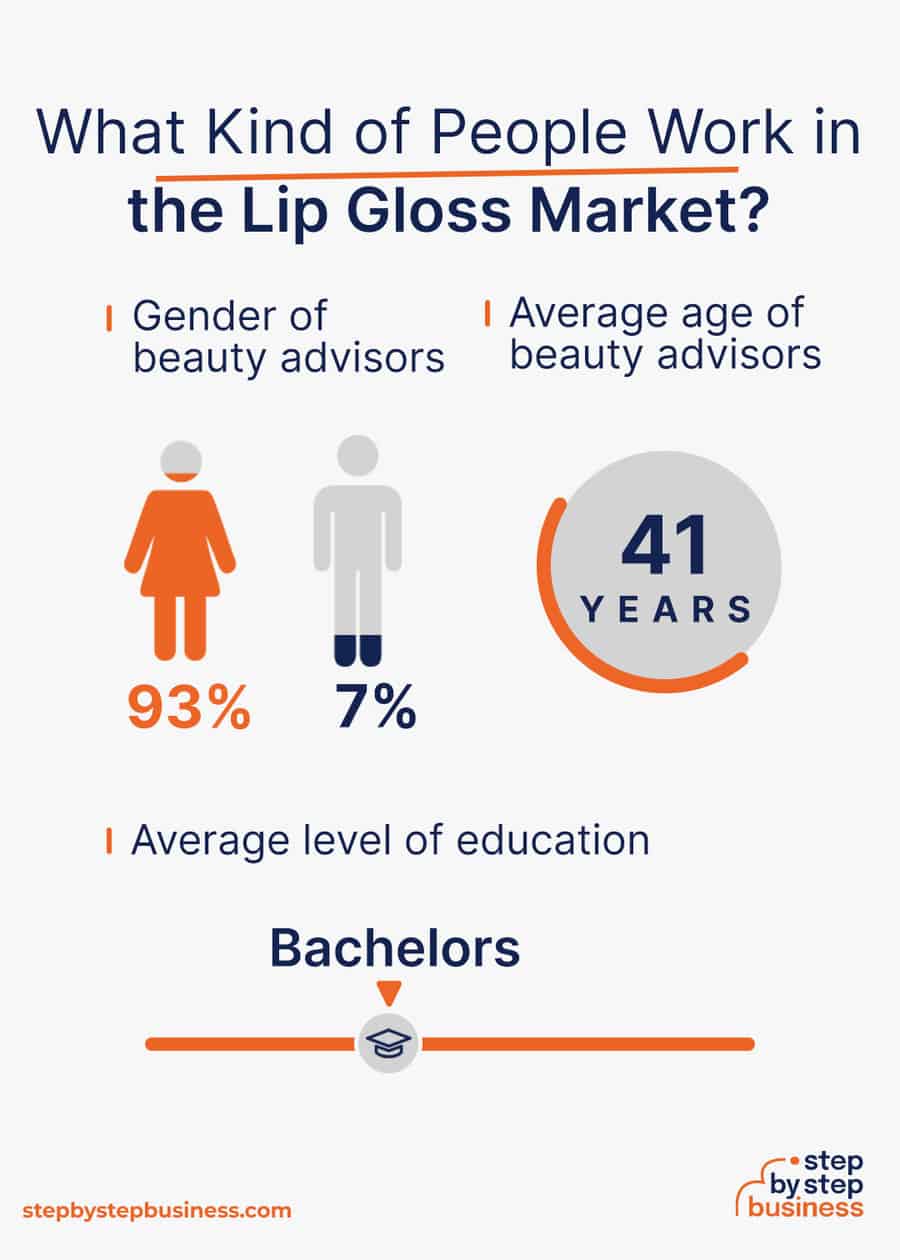
A beauty advisor can advise customers on what kind of lip gloss to buy.
Startup costs range from around $800 to almost $8,000 with an average of just over $4,000. On the high end, the largest expense is website development, but you can start by selling your lip gloss on online marketplaces such as Amazon or Etsy. Your initial supplies to make lip gloss vary based on how large or small you want to begin.
You’ll need a handful of different items to successfully launch your lip gloss business. Here’s a list to help you get started:
| Startup Costs | Ballpark Range | Average |
|---|---|---|
| Setting up a business name and corporation | $150 - $200 | $175 |
| Business licenses and permits | $200 - $300 | $250 |
| Insurance | $100 - $500 | $300 |
| Business cards and brochures | $200 - $300 | $250 |
| Website setup | $0 - $3,000 | $1,500 |
| Initial marketing budget | $100 - $500 | $300 |
| Lip gloss starting kit | $100 - $3,000 | $1,550 |
| Total | $850 - $7,800 | $4,325 |
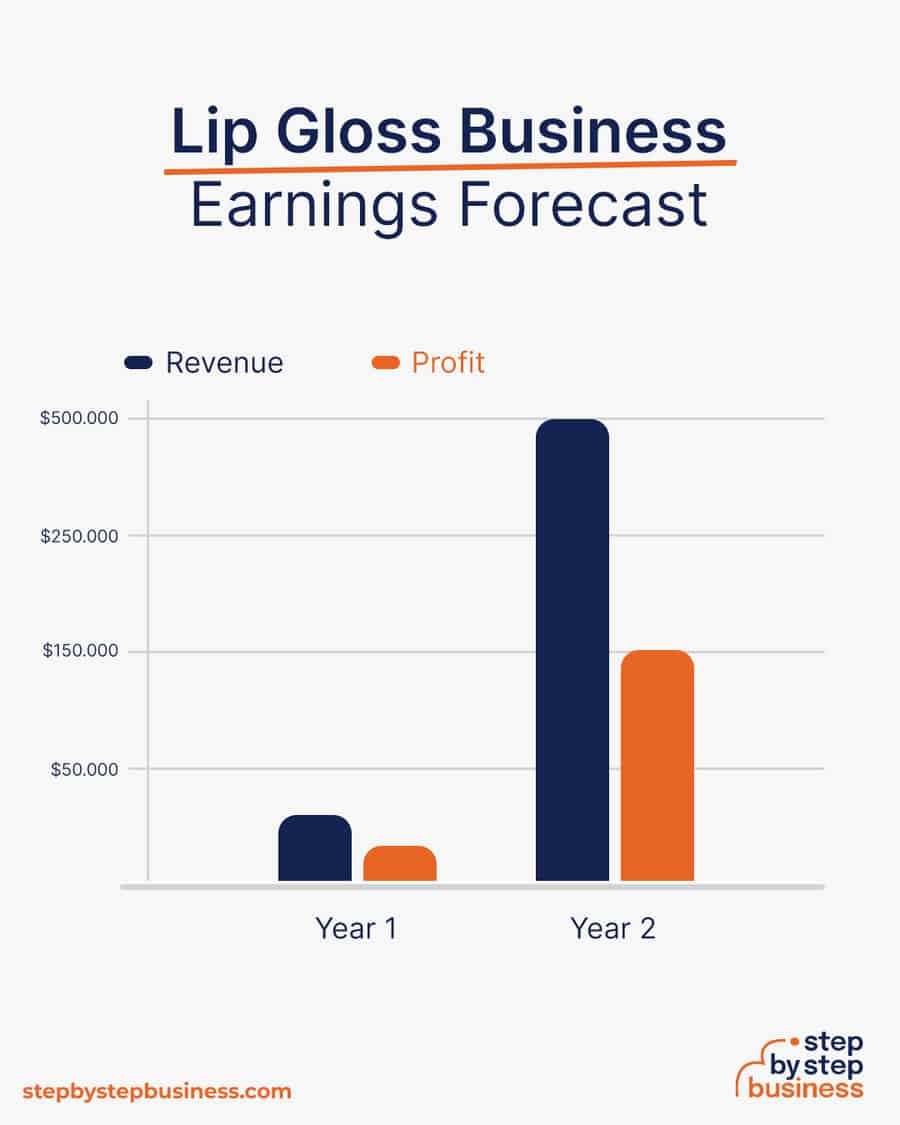
The cost to make a lip gloss is estimated at $2.50, while the same lip gloss can be sold at a retail price of $5, resulting in a 50% profit margin. High-end lip glosses can sell for much more, up to $40 or more. For larger cosmetic companies, profit margins are around 80%.
In the early stages, if you sell 5,000 units in a year at $5 each, you will bring in $25,000 in annual revenue. This equates to $12,500 in profit (50% margin).
As your brand gains recognition, sales could climb to 50,000 units a year. At this stage, you would rent a commercial space and hire staff, reducing your profit margin to around 30%, but you also may be able to command a higher price. If you sell 50,000 units at $10 per unit, you will bring in $500,000 in revenue, and $150,000 in profit.
There are very few barriers to entry for a lip gloss business. Your biggest challenges will be:
Now that you know what’s involved in starting a lip gloss business, it’s a good idea to hone your concept in preparation to enter a competitive market.
Market research will give you the upper hand, even if you’re already positive that you have a perfect product or service. Conducting market research is important, because it can help you understand your customers better, who your competitors are, and your business landscape.
Examine the lip gloss market to determine what other companies are selling. Do you see anything that is missing or rare? Look for new trends where there may be an opportunity. It could be a certain texture or look, such as glitter, or creative colors.
You might consider targeting a niche market by specializing in a certain aspect of your industry.
If you’re interested in starting a lip care business, this interview with LIPSMART’s Briana Brumer offers essential insights and strategies for success in the industry.
Determine what products you want to offer in your lip gloss line. Create a list of colors or types of lip gloss. You may do some experimentation making your glosses and come up with 10 colors or other variations that you want to offer.
The average price of lip gloss is around $5, but prices can be much higher. In the beginning, you will probably need to be at the lower end of the price range, but you may be able to increase your prices later as you gain brand recognition.
Once you know your costs, you can use this Step By Step profit margin calculator to determine your mark-up and final price points. Remember, the prices you use at launch should be subject to change if warranted by the market.
You need to know who your market is, so that you know where to find those people. For example, you may decide to offer glittery lip gloss which will probably attract a younger market, and you can most likely find them on social media sites like Instagram and TikTok.
In the early stages, you may want to operate your business from home to keep expenses relatively low. But as your business grows and operations intensify, you will likely need to hire workers for various roles. You may need to rent out a production facility to manufacture your products. If you have a manufacturer, you may still need an office for your staff to work in. Find commercial space to rent in your area on Craigslist, Crexi, and Instant Offices.
When choosing a commercial space, you may want to follow these rules of thumb:
Here are some ideas for brainstorming your business name:
Discover over 190 unique lip gloss business name ideas here. If you want your business name to include specific keywords, you can also use our lip gloss business name generator. Just type in a few keywords and hit “generate” and you’ll have dozens of suggestions at your fingertips.
Once you’ve got a list of potential names, visit the website of the US Patent and Trademark Office to make sure they are available for registration and check the availability of related domain names using our Domain Name Search tool below. Using “.com” or “.org” sharply increases credibility, so it’s best to focus on these.
Finally, make your choice among the names that pass this screening and go ahead with domain registration and social media account creation. Your business name is one of the key differentiators that set your business apart. Once you pick your company name, and start with the branding, it is hard to change the business name. Therefore, it’s important to carefully consider your choice before you start a business entity.
Here are the key components of a business plan:

If you’ve never created a business plan, it can be an intimidating task. You might consider hiring a business plan specialist to create a top-notch business plan for you.
Registering your business is an absolutely crucial step — it’s the prerequisite to paying taxes, raising capital, opening a bank account, and other guideposts on the road to getting a business up and running.
Plus, registration is exciting because it makes the entire process official. Once it’s complete, you’ll have your own business!
Your business location is important because it can affect taxes, legal requirements, and revenue. Most people will register their business in the state where they live, but if you are planning to expand, you might consider looking elsewhere, as some states could offer real advantages when it comes to lip gloss.
If you’re willing to move, you could really maximize your business! Keep in mind, it’s relatively easy to transfer your business to another state.
Business entities come in several varieties, each with its pros and cons. The legal structure you choose for your lip gloss will shape your taxes, personal liability, and business registration requirements, so choose wisely.
Here are the main options:

We recommend that new business owners choose LLC as it offers liability protection and pass-through taxation while being simpler to form than a corporation. You can form an LLC in as little as five minutes using an online LLC formation service. They will check that your business name is available before filing, submit your articles of organization, and answer any questions you might have.
Choose Your State
The final step before you’re able to pay taxes is getting an Employer Identification Number, or EIN. You can file for your EIN online or by mail or fax: visit the IRS website to learn more. Keep in mind, if you’ve chosen to be a sole proprietorship, you can simply use your social security number as your EIN.
Once you have your EIN, you’ll need to choose your tax year. Financially speaking, your business will operate in a calendar year (January–December) or a fiscal year, a 12-month period that can start in any month. This will determine your tax cycle, while your business structure will determine which taxes you’ll pay.
The IRS website also offers a tax-payers checklist, and taxes can be filed online.
It is important to consult an accountant or other professional to help you with your taxes to ensure you are completing them correctly.
Securing financing is your next step and there are plenty of ways to raise capital:
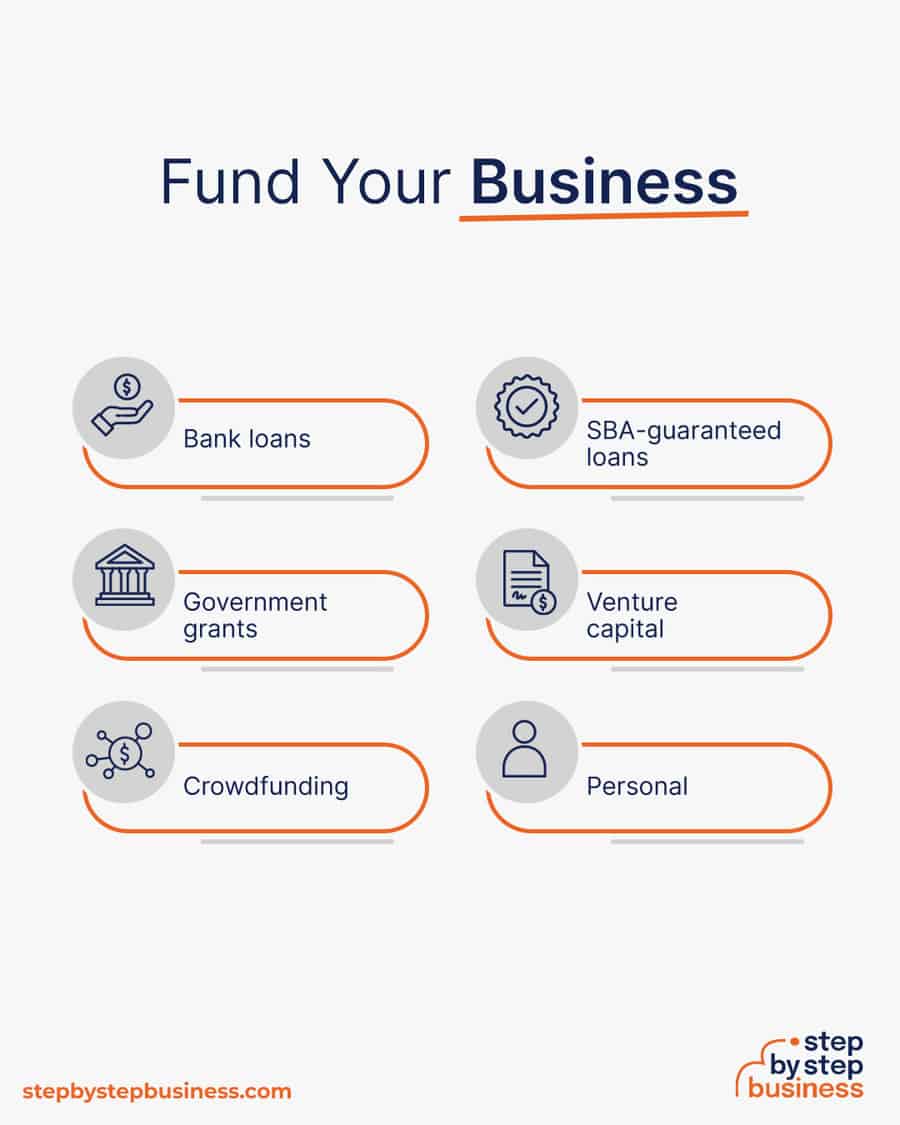
Bank and SBA loans are probably the best options, other than friends and family, for funding a lip gloss business. You might also try crowdfunding if you have an innovative concept.
Starting a lip gloss business requires obtaining a number of licenses and permits from local, state, and federal governments.
Federal regulations, licenses, and permits associated with starting your business include doing business as, health license and permit from the Occupational Safety and Health Administration (OSHA), trademarks, copyrights, patents, and other intellectual properties, as well as industry-specific licenses and permits.
If you are making your own lip gloss, you will need to check FDA regulations to make sure that your ingredients are in compliance.
You may also need state-level and local county or city-based licenses and permits. The license requirements and how to obtain them vary, so check the websites of your state, city, and county governments or contact the appropriate person to learn more.
You could also check this SBA guide for your state’s requirements, but we recommend using MyCorporation’s Business License Compliance Package. They will research the exact forms you need for your business and state and provide them to ensure you’re fully compliant.
This is not a step to be taken lightly, as failing to comply with legal requirements can result in hefty penalties.
If you feel overwhelmed by this step or don’t know how to begin, it might be a good idea to hire a professional to help you check all the legal boxes.
Before you start making money, you will need a place to keep it, and that requires opening a bank account.
Keeping your business finances separate from your personal account makes it easy to file taxes and track your company’s income, so it’s worth doing even if you’re running your lip gloss business as a sole proprietorship. Opening a business bank account is quite simple, and similar to opening a personal one. Most major banks offer accounts tailored for businesses — just inquire at your preferred bank to learn about their rates and features.
Banks vary in terms of offerings, so it’s a good idea to consider your options to choose the best plan that works for you. Once you choose your bank, you’ll need to bring your EIN (or Social Security Number if you decide on a sole proprietorship), articles of incorporation, and any other legal documentation that proves your business is registered.
Business insurance is an area that often gets overlooked yet is vital to your success as an entrepreneur. Insurance protects you from unexpected events that can have a devastating impact on your business.
Here are some types of insurance to consider:

As opening day nears, prepare for launch by reviewing and improving some key elements of your business.
Being an entrepreneur often means wearing many hats, from marketing to sales to accounting, which can be overwhelming. Fortunately, many websites and digital tools are available to help simplify many business tasks.
You may want to use industry-specific software such as Ecwid, BrandCrowd, and visualretailplus to manage point-of-sale system and inventory, sell on online platforms, and more.
Website development is crucial because your site is your online presence and needs to convince prospective clients of your expertise and professionalism.
You can create your own website using website builders. This route is very affordable, but figuring out how to build a website can be time-consuming. If you lack tech-savvy, you can hire a web designer or developer to create a custom website for your business.
They are unlikely to find your website, however, unless you follow Search Engine Optimization (SEO) practices. These are steps that help pages rank higher in the results of top search engines like Google.
Here are some powerful marketing strategies for your future business:

Unique selling propositions, or USPs, are the characteristics of a product or service that sets it apart from the competition. Customers today are inundated with buying options, so you’ll have a real advantage if they are able to quickly grasp how your product meets their needs or wishes. It’s wise to do all you can to ensure your USPs stand out on your website and in your marketing and promotional materials, stimulating buyer desire.
Global pizza chain Domino’s is renowned for its USP: “Hot pizza in 30 minutes or less, guaranteed.” Signature USPs for your lip gloss business could be:
You may not like to network or use personal connections for business gain. But your personal and professional networks likely offer considerable untapped business potential. Maybe that Facebook friend you met in college is now running a lip gloss business, or a LinkedIn contact of yours is connected to dozens of potential clients. Maybe your cousin or neighbor has been working in cosmetics for years and can offer invaluable insight and industry connections.
The possibilities are endless, so it’s a good idea to review your personal and professional networks and reach out to those with possible links to or interest in lip gloss. You’ll probably generate new customers or find companies with which you could establish a partnership. Online businesses might also consider affiliate marketing as a way to build relationships with potential partners and boost business.
If you’re starting out small from a home-based office, you may not need any employees. But as your business grows, you will likely need workers to fill various roles. Potential positions for a lip gloss business would include:
At some point, you may need to hire all of these positions or simply a few, depending on the size and needs of your business. You might also hire multiple workers for a single role or a single worker for multiple roles, again depending on need.
Free-of-charge methods to recruit employees include posting ads on popular platforms such as LinkedIn or Facebook. You can also use free classified sites like Jobs and AngelList. You might also consider a premium recruitment option, such as advertising on Indeed, Glassdoor, or ZipRecruiter. Further, if you have the resources, you could consider hiring a recruitment agency to help you find talent.
Starting a lip gloss business can be a great way to have fun and make a healthy profit, and you don’t need a fortune to get started. You can work from home when you start and use your creative talents to make a great product and market it. Lip gloss has a large market and is a growing industry, and a small lip gloss business can potentially become a large company.
You have all the information that you need at your fingertips now, so get started on your journey to building a successful lip gloss business!
You can have any kind of business entity to start a lip gloss business. You can start as a sole proprietor if you choose, and you don’t have to register your business with your state. An LLC, however, gives you personal liability protection and has tax advantages over a corporation.
Lip gloss is competitive market, so you need creative and quality products, attractive packaging, and an effective value proposition that reflects your USPs. To grow, you will also need to put together an effective marketing plan and have a budget to execute your plan.
Key ingredients commonly used in lip gloss products include oils (such as castor oil, coconut oil, or jojoba oil) for moisture and shine, waxes (such as beeswax or candelilla wax) for texture and hold, pigments or dyes for color, and flavorings or scents for added appeal.
The regulations regarding the sale of homemade lip gloss can vary depending on your location. It is important to research and comply with the legal requirements set by relevant authorities, such as obtaining necessary licenses, following health and safety guidelines, and ensuring proper labeling of your products.
Lip gloss can be profitable, as it is a popular cosmetic product with a consistent consumer demand. Success in the lip gloss business depends on various factors such as product quality, branding, pricing strategy, marketing efforts, and market competition.
To stand out with your lip gloss business, focus on creating unique and visually appealing packaging. Use high-quality ingredients to ensure your products perform better than others. Offer a wide variety of shades and finishes to cater to diverse preferences. Highlight natural or vegan ingredients if applicable. Incorporate trendy features like long-lasting or multi-purpose formulas. Engage actively with your audience on social media and build relationships through influencer partnerships. Finally, enhance your reputation with outstanding customer service and personalized shopping experiences.

Published on July 28, 2022
The beauty industry is huge, and still growing. The US is one of the largest markets, and there’s always room for appealing and innovativeprod ...
Read Now

Published on June 30, 2022
Women run more than 11 million US businesses. That’s a lot less than the number run by men, but one thing is certain — women are just asinno ...
Read Now

Published on June 8, 2022
From the runway to your closet, fashion is everywhere. Clothing is a necessary part of life, and it also allows people to express themselves andshow ...
Read Now
No thanks, I don't want to stay up to date on industry trends and news.
Comments